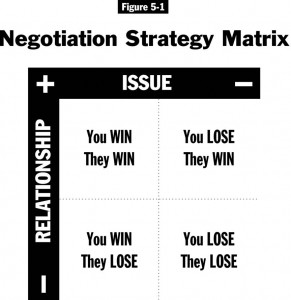What Does Win-Win Negotiation Mean?
Win-Win ranks high on the list of overused buzzwords, but many of us have trouble understanding the counter intuitive notion that two sides can win when a product or service is bought and sold. Win-Win is not only obtainable, it is the ideal result. How then does it work?
Negotiation strategy always has a profound impact on business. There are four strategies; they are: Win-Win, Win-Lose, Lose–Win, and Lose-Lose.
Selecting the appropriate strategy depends upon how the parties value the Issue and the Relationship. A visual aid works well to explain this concept. The chart below is taken from my book, You’re the Buyer – You Negotiate It to help to explain the four different strategies available, how they depend on Issue and Relationship, and when to use them.
Let’s begin with Win-Lose in the lower left quadrant because this is the type most frequently practiced. Many folks who profess Win-Win actually believe that all that matters is that they win. Sports competition conditions us to this conclusion because most often, there must be a winner and a loser. Can you hear the growl of the primitive instinct, “And I’m not going to be the loser!”
Take Lose-Win next, in the upper right quadrant. This one is tough to grasp for many buyers when role playing as sellers. At purchasing seminars, I confront them with this situation.
Assume that your relationship with a good customer has grown chilly. Orders are down, communication is limited, yet you can not identify the problem. At a face to face settlement meeting, the chair you are offered across the buyer’s desk is low and uncomfortable. If you sit, the sun will all but blind you. What should you do?
The most common responses from the buyers are “Remain standing”, “Move the chair”, and “Close the blinds”. If the Relationship is valued more than the Issue, the graphic above suggests that you should select Lose-Win. If you were to sit in the low, blinding chair, the customer can exercise control. By planning to lose over the Issue, you may allow the buyer to be comfortable enough to express the problem. Then, you can rectify it and preserve the Relationship. You might even increase sales as a result of your ‘owning’ up to your problem.
Lose-Lose , in the lower right quadrant may not seem to make sense, but in rare situations, it could. For example, suppose that you are assigned the duty of buying photography services for the company June outing. Every bona fide photographer has been booked for months for weddings, reunions, and graduations. The only photographers you can get are two college physics students, whose long-term career plans involve photographing gamma wave radiation!
This is a clear-cut demand for the Lose-Lose strategies. Who cares about the Relationship? It has no future. And as for the Issue, do you really want high-resolution photography of employees who have overindulged all day, maybe kissing the wrong spouse? To be sure, the conditions under which Lose-Lose is appropriate will be few, but it is the advisable choice in those rare instances when Issue and Relationship have little value.
Now we come to Win-Win, in the top right quadrant. Here, we recognize that one shot deals do not apply. Each party has a vested interest in the Issue and the Relationship. Think of this strategy as the basis for a marriage, a long term committed Relationship where Issue tend to have mutual importance. When the Relationship and the Issue are both important, the only appropriate strategies of negotiation is Win-Win. An example is the current trend in business to pare back the number of suppliers. The motivating force is to reduce costs and raise profits for both buyer and seller. The long-term business Relationship matters as much as the Issue of profitability. Win-Win should be the ideal strategies, and in all cases involving major customers and suppliers, should be our only choice.


